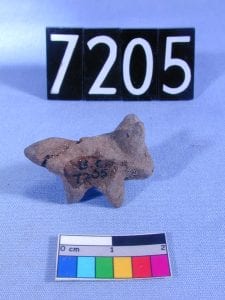Object of the Week: A child’s toy pig
By Alice E Williams, on 3 August 2018
We have some exciting news about Specimen of the Week! We’re expanding the scope of SOTW to include more UCL Museums and collections. Here’s the first blog from the Petrie Museum of Egyptian Archaeology, and keep your eyes peeled for blogs about specimens and objects from UCL Art Museum, UCL Pathology Museum and more as well as your favourites from the Grant Museum.
In a display case in the Petrie Museum of Egyptian Archaeology stands a little mud figure of a pig. At least it is thought to be a pig. It is so small, no bigger than a thumb nail, that you would be excused for not noticing it among the dense displays of archaeological objects. This figurine was originally thought to be a toy made by a child, but is that really true?
Life at Lahun
This little object is believed to date from the 12th Dynasty (c. 1976-1793 BCE) and was excavated in the town of Lahun, a settlement located in Egypt’s Fayum, around 100km southwest of Cairo. The town was built in the late Middle Kingdom to house Senusret II’s pyramid builders and their families and is considered one of the best preserved ancient Egyptian settlements sites. When Petrie and his colleagues first excavated the site in 1889 they uncovered a wealth of objects detailing daily life. Petrie described the experience as quite remarkable:
“…it is hard to believe that over four thousand years have glided by since those houses last echoed to the voices of the occupants… so intimate may you now feel in walking their streets, and sitting down in their dwellings, that I shall rather describe them as a living community than as historical abstractions.” Petrie 1890, 21.
Within this thriving ancient community Petrie seemed quite fascinated by the lives of Lahun’s children, commenting on how children’s toys were found “in abundance”. He lists the discovery of dolls, balls, and board games, as well as items that he likened to Victorian whiptops and tipcats. Among these finds were a selection of figurines made from Nile mud, including this little pig, all of which Petrie identified as toys made by children.
This group of figurines were shaped to resemble animals found in the ancient landscape, such as crocodiles, jackals, water birds, and lizards, as well as boats and human figures. Many of these can be found on display in the Petrie Museum. They were all moulded by hand, with the dents and impressions of fingertips still left on the surface. Every figurine varies in size, but each one can fit in the palm of your hand.
Hide and Seek
Were Petrie’s interpretations right? Were these little figurines actually made by children? There are a number of reasons why we might think this: the use of mud as a free and readily available material, the crude shaping of the figures, the familiar choice of subject matter, even their miniature size is something often associated with children’s toys.
But perhaps Petrie was led too much by his own modern, western ideas of childhood and what a child’s toy should look like. The discovery of similar figurines outside of domestic areas in Egypt, in contexts not necessarily associated with children, has led some Egyptologists to since question whether they may have been made by adults to serve a ritual function.
Either way, these little traces of possible child activity raise much bigger questions about the visibility or indeed invisibility of ancient children in archaeological evidence. Despite children playing an important and active role in shaping the material world, there has been a tendency for archaeologists to focus too much on the material culture of adults. Childhood objects can also be difficult to determine unless they are found buried with infants or children. As a result the lives of ancient children are often overlooked or hidden, and can remain missing from the stories that museums tell.
The Petrie Museum houses over 80,000 objects reflecting the everyday lives of ordinary ancient Egyptians across a wide range of social groups, but where are all the children? I wonder just how many objects made or used by children are hiding in our collection just waiting to be discovered.
Alice Williams is the Curatorial and Collections Assistant at the Petrie Museum of Egyptian Archaeology
References
Petrie, W. M. F., 1890. Kahun, Gurob, Hawara, p. 30 pl. VIII
Petrie, W. M. F, 1927. Objects of Daily Use, p. 61, pl. LIII
Quirke, S., 1998. Figures of clay: Toys or ritual figurines? In: S. Quirke (ed.), Lahun Studies, 141-151.
Quirke, S., 2005. Lahun: A town in Egypt 1800 BC, and the history of its landscape.
Szpakowska, K., 2008. Daily Life in Ancient Egypt: Recreating Lahun.
 Close
Close




